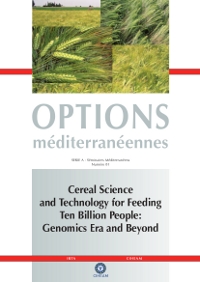| Article précédent | p. 441-444 | Article suivant |
Analysis of the expression of homoeologous genes in polyploid cereals using fluorescence cDNA-SSCP
Most cereals have genomes with redundant genes arising from genome doubling or polyploidy. Differences in the expression levels of duplicate genes have long been a subject of great interest since new genes can arise from redundant duplicates. Such analysis requires a technique that can discriminate between the expressions of two (or more) almost identical genes (homoeologues). In previous works we isolated and characterized the sequences of the gene Mre11 in the genomes A, B and D of Triticum aestivum L., involved in the homologous recombination mechanism. Herein we report the results of application of an improved method based on the cDNA-SSCP technique reported by Cronn and Adams (2003), using fluorescence labelling and automatic sequencing. The results obtained in both tetraploid and hexaploid species indicated a lower expression of Mre11 gene from the B genome respect to genes from genomes A and D.
- [ Afficher ]
- [ Télécharger ]
- [ Exporter la citation ]
Vous pouvez télécharger la citation au format :
- [ Imprimer ]
-
Mots-clés
CEREALE, FLUORESCENCE, GENE, GENETIQUE, GENOME, POLYPLOIDIE, RECOMBINAISONCiter cet article
De Bustos A., Perez R., Jouve N. Analysis of the expression of homoeologous genes in polyploid cereals using fluorescence cDNA-SSCP. In : Molina-Cano J.L. (ed.), Christou P. (ed.), Graner A. (ed.), Hammer K. (ed.), Jouve N. (ed.), Keller B. (ed.), Lasa J.M. (ed.), Powell W. (ed.), Royo C. (ed.), Shewry P. (ed.), Stanca A.M. (ed.). Cereal science and technology for feeding ten billion people: genomics era and beyond. Zaragoza : CIHEAM / IRTA, 2008. p. 441-444. (Options Méditerranéennes : Série A. Séminaires Méditerranéens; n. 81). Meeting of the Eucarpia Cereal Section, 2006/11/13-17, Lleida (Spain). http://om.ciheam.org/om/pdf/a81/00800899.pdf



